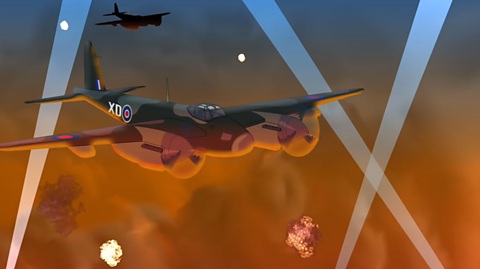Key points
After World War Two started in September 1939, the Nazis initially moved east, invading Poland, Hungary and the Soviet Union.
This brought millions of Jewish people under their control. The Nazis decided to increase their persecution of Jewish people, and eventually resolved to murder them.
At the Wannsee Conference, senior Nazis set out how they would implement their plan to commit mass murder.
Video about the Holocaust
A young Jewish girl called Lotte shares her experience of the Holocaust
Lotte:
Before the rise of Hitler and the Nazis, our family had a good life in Germany. My brother and I had many friends at school and we were good students. My father worked buying and selling livestock around the country. We were Jewish and we were Germans. We led normal lives.
After Hitler became Chancellor of Germany in 1933 our lives changed dramatically. The first thing we noticed was our parents whispering. They were fearful, worried all the time.
Nazi soldiers and supporters marched through the streets. Adolf Hitler shouted and screamed on the radio, spreading his hate and antisemitic views, that Jews and other groups were responsible for all of Germany’s problems. I felt so confused and hurt. People started to look at us differently. Our housekeeper left us saying she could no longer work for us.
And then in 1938, ‘Kristallnacht’ the night of broken glass, that is what it was called, but it was far more than broken glass. The Nazi Party encouraged and helped organise it. Their supporters ransacked Jewish homes, schools and shops. Our synagogue was set on fire and destroyed. We were scared to worship. We were not allowed to go to school anymore. We no longer felt safe in our homes.
My mother arranged for me to get out of Germany on the Kindertransport. They were special trains that had been organised by the British and others to help transport Jewish children like me under 17 years of age out of Germany. We were to be resettled in other European countries where Jews were safer.
The Nazi guards with guns watched me as I walked to the train station. I was terrified that I would be arrested or worse at any moment, but I pretended to smile being polite. My mother broke down in tears as I boarded the Kindertransport train to the Netherlands. At Hook of Holland I was put on a boat for Britain. I was 14 years old. I wept, terrified as I sailed away from my home, my family, my mother and my brother, they stayed in Germany.
The Nazis started forcing Jews to wear yellow stars on their clothes, so they could be identified as Jewish and treated differently. Many people were taken by the Nazi secret police, the Gestapo, to the concentration and death camps. We never heard from them again. My father and brother escaped across the border to Switzerland, but my brother was put to work in a labour camp there and forced to build roads by the Swiss government.
I never saw my mother again. I later found out she had been taken to a concentration and extermination camp. She was murdered by the Nazis with six million other Jewish people.
Defining the Holocaust
The Holocaust was the murder of approximately six million Jewish men, women and children by Nazi Germany and its collaboratorA person, organisation or country who worked with the Nazis to persecute and murder Jewish people, and other targets of Nazi persecution, during World War Two. during World War Two.
The word ‘Holocaust’ comes from two Ancient Greek words: ‘holos’, which means ‘completely’, and ‘kaustos’, meaning ‘burnt’. The original meaning of this word referred to a religious sacrifice, which the mass murder of Jewish people was not. As a result, many people prefer to use a different term, such as the Hebrew word ‘Shoah’, which means ‘catastrophe’.
The NaziAn abbreviation for the National Socialist German Workers’ Party (NSDAP) and its members. The term was originally thought up by political opponents of the party. The Nazi Party's main ideas were based on racism, including antisemitism, and hostility towards democracy and other political systems, such as communism and socialism. and their collaborators persecutionTreating people poorly based on their political beliefs, race, religion or sexuality. and murdered many other groups of people, too. Slavic peoplesAn ethnic group living in Poland, the Soviet Union, Ukraine, Yugoslavia, Czechoslovakia and Bulgaria., RomaAn ethnic group originating in South Asia who migrated to Europe from the Middle Ages onwards. and SintiThe group of Roma people who lived in central and eastern Europe., Black people and mixed race people were targeted because they did not fit within the Nazis’ racist idea of a master 'Aryan race'An idea developed in the 1800s, believed by Hitler and the Nazis, that people from northern and western Europe were racially 'superior' to other groups. There is no scientific basis for this idea.. This idea had first developed during the 1800s, and was based on the false belief that people from northern and western Europe were racially superiorBeing better or of a higher quality. to groups of people from outside these regions. There is no scientific basis for these beliefs.
The Nazis’ false belief in genetic superiority also led to the persecution and murder of people with disabilities. Gay men were targeted for slightly different reasons, mainly because the Nazis believed that they were ‘failing’ in their duty to the creation of the so-called ‘Aryan race’ by supposedly not having children.
Other groups of people were persecuted because they were political opponentA person who is against the ideas of another person, organisation or government. of the Nazi regime. Jehovah's WitnessesA Christian group founded in the 1800s who disagree with many traditional Christian teachings and beliefs., for instance, refused to accept Nazi rule because of their spiritual beliefs. They were also opposed to war. prisoner of warA person who is captured and held by the forces of the opposing side during a war.from the Soviet Union suffered persecution and murder on the basis of their political opposition to Nazi rule, and because they were from eastern Europe, and therefore not part of the so-called ‘Aryan race’.
All of these groups of people were persecuted in different ways and for different reasons, all of which were rooted in Nazi ideas. There is more information about the persecution of these groups of people in this guide about non-Jewish victims of Nazism.
Ghettos
In September 1939, Germany invaded Poland. This started World War Two. There were 3.5 million Jews living in Poland at the time.
The Nazis decided that they would build ghettoA sealed off area of a town or a city designed to limit people’s movement, and cut them off from the rest of the population. in towns and cities in Poland, forcing Polish Jews to move into them. The largest ghetto was in Warsaw, which grew to contain over 400,000 Jews. Walls were built around some ghettos, to separate them from the rest of the city or town. If people escaped from the ghetto and were caught, they would be killed.
In the Warsaw Ghetto, Jews were forced to wear a white armband with a blue Star of David printed on it.
Conditions in ghettos were appalling. On average, there were between eight and ten people living in every room. Food rations were deliberately low. On average, people received 1,200 calories a day in 1940, and this later dropped further. Between 1940 and 1942, it is estimated that up to 100,000 people died of starvation in the Warsaw ghetto.
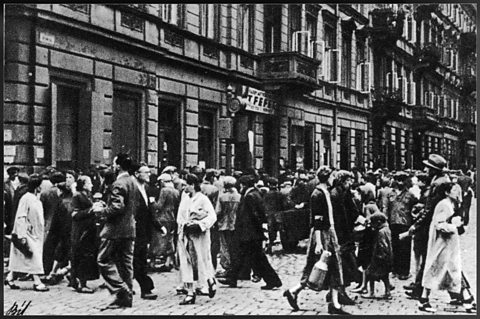
What was it like to live in the Warsaw ghetto?
Janina Dawidowicz was 11 years old when she and her family were sent to the Warsaw Ghetto from their home in the town of Kalisz, near the border with Germany.
She was one of very few people who survived life in the ghetto, and recalled the terrible conditions there, where she and her family were forced to live in one room, which was extremely damp. She and her family were forced to eat just bread and potatoes, which was mixed with sawdust.
Janina’s parents arranged for her to be smuggled out of the ghetto, and she was hidden in Warsaw by Catholic nuns. Her parents remained in the ghetto, and she never saw them again. She doesn’t know for certain how or where her mother was killed, and she thinks that her father may have been murdered in the Majdanek extermination camp.
After the war, Janina trained to become a social worker.
Operation Barbarossa
In June 1941, Germany invaded the Soviet Union. This was codenamed ‘Operation Barbarossa’.
As the German army advanced east, 3,000 SSThe Schutzstaffel, an organisation led by Heinrich Himmler that was originally set up to be Hitler’s personal bodyguard service. Its members later set up concentration camps, and were specifically given the responsibility for murdering Jewish people. troops, who were split into four units, rounded up groups of Jews and shot them dead. These four units of SS troops were called the EinsatzgruppenMobile units of the Nazi security forces (the SS) who were responsible for mass killings, usually by shooting, across Nazi-occupied Europe.. They often acted with the assistance of the Waffen-SS The military branch of the Nazi Party’s SS organisation., the Order PoliceThe uniformed police force of Nazi Germany from 1936-1945. Known as ‘Ordnungspolizei’ in German., the German army and local collaboratorA person, organisation or country who worked with the Nazis to persecute and murder Jewish people, and other targets of Nazi persecution, during World War Two.. It is estimated over 2 million Jews had been murdered in this way by 1944.
Historians have referred to the Nazis’ policy of committing mass murder by shooting as the ‘Holocaust by bullets’.
In September 1941, members of the Einsatzgruppen murdered almost 34,000 Jews over a two-day period at Babyn Yar, also known as Babi Yar, near the city of KyivThis is the capital city of modern-day Ukraine., in Ukraine. This was one of many sites of the mass murder of Jewish people across Eastern Europe.
Persecution in the occupied territories
Nazi Germany invaded and occupied many countries across Europe following the outbreak of war. Jews and other groups of people suffered persecution across the continent.
This was often made possible with the collaboration of local police and government organisations. Following their defeat to the German army, France was controlled by the German government. However, at times, French authorities went beyond what they were asked to do by their German occupiers. Marshal Philippe Pétain, a French general who had fought in World War One, became head of state. His government brought in many antisemitic laws and policies. Pétain also opened several concentration campA place where large numbers of Jewish people, and members of other minority groups persecuted by the Nazis, were held captive during World War Two. in France, and his government participated in the murder of Roma people.
In Belgium, in 1940, the Nazi occupiers forced Jewish people to register with the authorities, and introduced laws that discriminated against Jews. By the end of 1940, Jewish people were not allowed take up jobs in several professions. In the Netherlands, the Dutch civil serviceThe part of a government that looks after the day-to-day running of different government departments. carried out the Nazis’ demand to make a register of Jewish people, in January 1941.
The Wannsee Conference
In January 1942, a meeting was held at Wannsee, on the outskirts of Berlin. Leading members of the Nazi government and the SS were present. The meeting was chaired by Reinhard Heydrich, who was head of the Reich Security Main Office. Heydrich had helped to organise ‘Kristallnacht’ and set up the Einsatzgruppen.
At the Wannsee Conference, Heydrich set out the plans for the mass transportation of Jews from across Nazi occupied territory to Eastern Europe, where they would be murdered through forced labour, starvation and disease, or in the gas chambers of newly built extermination campCamps that were set up by the Nazis so that they could carry out the mass murder of Jewish people. Most of the people who were sent to these camps were murdered as soon as they arrived.. This was referred to as the ‘Final Solution of the Jewish question’, which was the phrase that the Nazis used for the Holocaust. The ‘Final Solution’ was a decision to set out to murder all Jewish people in Nazi-occupied Europe.
Extermination camps were built, and from 1942 the Nazis began what they called ‘liquidating the ghettos’. This meant that people were taken out of the ghettos and sent to extermination camps.
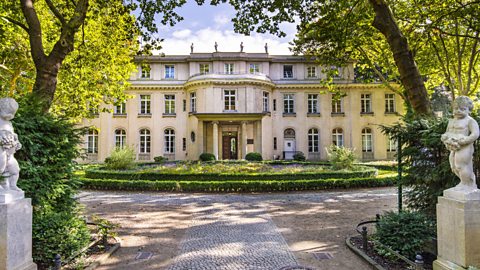
Extermination camps
Following the Wannsee Conference, the SS began the mass transportation of Jews from ghettos and Nazi occupied territory to extermination camps in Eastern Europe. There were six of these camps:
Auschwitz-Birkenau
Belzec
∞‰≥Û±≈Ç≥æ≤‘¥«
Majdanek
Sobibor
Treblinka
Gas chambers were built at the camps, where people were murdered. The camps also had crematoriums to burn the bodies, reducing them to ashes. These were constructed with the intention of carrying out the ‘Final Solution’, the mass murder of millions of Jewish people.
What was the role of the Nazis’ collaborators in transporting Jewish people to extermination camps?
The transportation of Jewish people to extermination camps was not carried out by German SS officers acting alone. It was made possible because of the collaboration of police forces and governments across Nazi occupied territory.
For instance, in July 1942, around 9,000 French police officers participated in the ‘round-up’ of non-French Jewish men, women and children across Paris. The French Prime Minister, Pierre Laval, had previously agreed to this, and had even suggested that children under 16 could be taken, too. In total, 12,284 Jewish people were taken from their homes, with many thousands sent to a large sports stadium called the Vélodrôme d’Hiver. The conditions in the stadium were appalling. It was very hot with no water supply, and there were very few toilets. From here, people were sent to concentration camps, and then to extermination camps.
Auschwitz-Birkenau
The largest death camp was Auschwitz-Birkenau, built near Kraków, Poland. Approximately 1 million Jewish people were murdered at Auschwitz.
Like several other concentration and extermination camps, Auschwitz also had a number of sub camps, which were smaller camps attached to the main, larger camp.
Trains delivered people to Auschwitz from all over Nazi-occupied Europe. The trains were overcrowded and many people died on the journey.
On arrival at Auschwitz, people were split into two groups. One was those who were considered healthy enough to work, and the second was made up mainly of elderly people, women and children, who were sent straight to the gas chambers and killed.
Those selected for work were tattooed with a number when they arrived, had their hair shaved and were forced to wear a striped uniform. People were forced to do hard labour in very difficult conditions. When they became too frail to work, they were sent to the gas chambers.
Barracks were made up of wooden bunks. Each room was designed to hold up to 200 people, but often ended up with up to 2,000. People were forced to line up in roll call square every morning and evening to be counted. If the number of prisoners present did not match records, they were made to stand in the square until the missing people were accounted for.
Images of Auschwitz-Birkenau
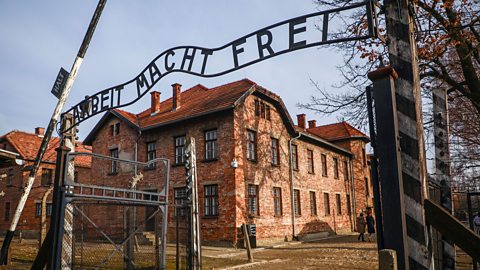
Image caption, The entrance to Auschwitz. The sign over the gate reads "Arbeit macht frei" which means "Work sets you free"
Image caption, Wooden bunks in a dormitory at Auschwitz
Image caption, Roll call square at Auschwitz, where prisoners were counted every morning and evening
Image caption, Jewish people from Hungary arriving at Auschwitz, June 1944
1 of 4
Map - Locations of Nazi persecution and murder
Jewish resistance
6 million Jews were murdered during the Holocaust. However, Jewish people found many different ways to resist Nazi persecution.Resistance was very common. Not all resistance was violent. For example, against Nazi orders, people in the ghettos established schools, to maintain education and morale.
Janina David, a Jewish child who lived in the Warsaw ghetto, remembered that parents would ‘organise small groups of children, four or five at a time… we met once or twice a week in somebody’s room… people learnt foreign languages: Latin, Greek, German, French, English’. People in the Łódź ghetto, Poland, even established a theatre. It opened in 1941 and mainly staged works written by Jewish artists. When the Nazis banned Jewish people from observing their religious customs, people resisted by continuing to practice their faith. Jews continued to observe religious festivals, such as Passover, and organised prayer groups.
Abraham Zwirek, a young Jewish man who lived in the Plock and Suchedniow ghettos, Poland, noted that ‘religious customs among Jewish people became very strong, although conducted in a quiet way’. In the concentration and extermination camps, people resisted by smuggling messages and information about what was happening to the outside world.
There were also a number of instances of Jewish people using violent and armed resistance against the Nazis, in both the ghettos and the concentration and extermination camps:
Warsaw ghetto: In April 1943, Jewish residents of the ghetto ambushed SS officers who were intending to transport Jews to death camps. This was the first civilian uprising anywhere in Nazi-occupied Europe. The resisters threw grenades and Molotov cocktailA homemade explosive device. at the SS soldiers, and they had support from resistance fighters outside the ghetto. The SS began burning down buildings in the ghetto and the uprising ended on 16 May 1943, with the blowing up of the Great Synagogue in the ghetto. It is estimated the SS had 110 casualties, and up to 13,000 Jews were killed by the SS. A concentration camp was built on the site of the ghetto ruins.
Treblinka: In August 1943, inmates at Treblinka seized weapons and set fire to buildings in the camp. Over 300 managed to escape and though many were captured and killed, it is estimated that 70 were not caught, and survived to the end of the war.
What was the Oneg Shabbat archive?
In October 1939, Emanuel Ringelblum, a Jewish historian, organised the ‘Oneg Shabbat’ project, to keep a record of life in the Warsaw Ghetto.
Along with other contributors, he collected lots of different objects, such as newspapers, diaries, poems, songs, drawings and ration cards. Ringelblum and his colleagues gathered their items during the day, and wrote notes about the material during the night. This material covered many topics, from daily life and religion to the Nazis’ use of forced labour. These items were then placed into metal boxes and milk cans and buried underground, so that the Nazis could not find them.
After the war, two of the three burial sites for the archive were found, though the third has never been discovered. Ringelblum and his contributors resisted by ensuring that future generations would have a record of life under Nazi occupation in Poland.
Liberation of the camps
The first extermination camp to be liberatedTo be set free. was Majdanek, in Poland. Soviet troops arrived there in July 1944.
Auschwitz was liberated six months later, in January 1945. When the Nazis realised that Soviet troops were close, the SS tried to move surviving inmates from Auschwitz to the west, on foot. These were called death marches, as many of the inmates were too frail or ill to walk this huge distance.
Jan Hartman, a young Czech Jewish man who was forced onto a death march, remembered it as ‘something unforgettable: the Polish countryside was under snow, freezing cold, January, the temperature must have gone down to 30 below zero or more, very cold’. When they arrived at Auschwitz, Soviet soldiers found 6,000 prisoners still alive.
Video - Survivor testimony
This video contains upsetting scenes. Henri Kichka, a Holocaust survivor, talks about his experience of being sent to Auschwitz.
Henri Kichka: (Speaking German) 1-7-7-7-8-9.
My name? No name. My address? No address. No school, no family. All my family died there.
They were arrested by Hitler, with me. I was one year in Auschwitz. It was horrible. It was not a life. It was dead. Only dead. My father, my mother, both sisters. They died in Auschwitz. They were gassed and burned.
The worst of all was the march of death. The death march. La marche de la mort. With the feet to march.
Reporter: No shoes?
Henri Kichka: It was horrible. All my feet are kaput!
I was 90% dead. After the war I was in a hospital, because I was very, very… a skeleton. I was a skeleton. I was in a sanitarium for lungs and in a hospital, and two years later I was married and I built a big family.
Antisemitism is an idea from crazy people. What for enemy is a Jew? He has no gun. He has no arms. They don’t do the war. And I don’t never understand why they hate so much the Jews. We are innocent.
The first days where I had to go in the school to tell my history, my horrible history, it was very difficult for me. I am crazy when I have to tell something what happened in the concentration camps.
But I know- I knew- that I had to tell it. And I told 10,000 people what I suffered there.
Test your knowledge and inference skills
Question 1
Gena Turgel was a Jewish woman who was born in Kraków, Poland. She lived in the Kraków ghetto before she was sent to Auschwitz in 1944, along with her mother and sister. Turgel and her mother were forced to join a death march, leaving behind her sister, who she never saw again.
Turgel survived the Holocaust, and spent the rest of her life sharing her experience with others. Read the below extract from one of her testimonies, and answer the questions.
‘At Auschwitz-Birkenau, every last remnant of respect and dignity was squeezed out of us. In our loose, insect ridden clothing and with our hair cropped or shaved, we felt completely dehumanised.’
How does Turgel describe life in Auschwitz?
What do you think she means when she says that those sent to Auschwitz were ‘dehumanised’?
From Turgel’s account, we can infer that life in Auschwitz was brutal. The fact that Turgel says that prisoners’ clothing was ‘insect-ridden’ suggests that there were poor hygiene conditions in the camps, and that people were not allowed to wash themselves or their clothes.
When Turgel describes those who were sent to Auschwitz as ‘dehumanised’ by the Nazis, she is referring to the fact that the treatment of prisoners was designed to take away their identity. Prisoners’ hair was shaved off and their clothes were taken away, replaced with striped uniforms. Numbers were tattooed onto inmates. These numbers were used instead of the prisoners’ names to identify them. These measures left the prisoners without many of things that defined them as individual people.
Question 2
Dawid Sierakowiak lived in the Łódź ghetto. He wrote a diary, which is a very useful source for historians who want to find out more about living conditions in the ghettos.
Read the extract below, which is taken from diary entries written in September 1941 and March 1942, and then answer the questions.
‘A transport of deportees arrived in the ghetto … The sick, children, and old people have been driven to hospitals, orphanages, and homes for the aged, but the rest are lying in empty houses on straw mats provided by the administration or on their own bedding … Our bread ration has been reduced, and vegetables don’t arrive anymore. Hunger is ever more terrifying … At work, food is almost the only topic of conversation (the food we had before the war, naturally).’
How does Sierakowiak describe the conditions in the Łódź ghetto?
For the people who lived in the ghetto, what would the consequences of these conditions be?
The diary entries describe food shortages and suggest that these became more of a problem after World War Two started. He remembers sick and old people being moved into the ghetto and the cramped, poor living conditions, with many people being forced to sleep on beds made of straw.
Many people in ghettos died of hunger due to severe food shortages. Overcrowding meant that disease outbreaks in ghettos were common, and illness would spread very quickly. Ghetto inhabitants were forced to work long hours in factories. The long hours, combined with the lack of food, meant many people died in the ghettos.
Question 3
Look at the picture below.
What is happening in this picture?
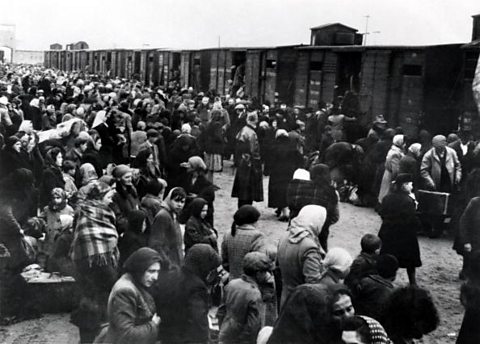
This photograph shows Jewish people from Hungary arriving at Auschwitz in June 1944.
On the right of this image, there is a train. Train lines were used to send people from all over Europe to Auschwitz. There are big crowds of people in this picture, which tells us that large numbers of people were forced onto trains and sent to Auschwitz.
When people arrived at Auschwitz, they were split into two groups. People were forced to form two lines: men and older boys in one, and women and children in the other.
Nazi officials made very quick assessments of arrivals. They decided who would be physically capable of hard labour, and who would not. Those who were not selected for ‘work’ were sent straight to the gas chambers. Many people who were sent to Auschwitz were killed shortly after arriving.
About 20% of people were selected for ‘work’. The rest were sent to the gas chambers.
The gave advice and guidance during the production of this guide.
Play the History Detectives game! gamePlay the History Detectives game!
Analyse and evaluate evidence to uncover some of history’s burning questions in this game.

More on World War Two and the Holocaust
Find out more by working through a topic
- count10 of 10
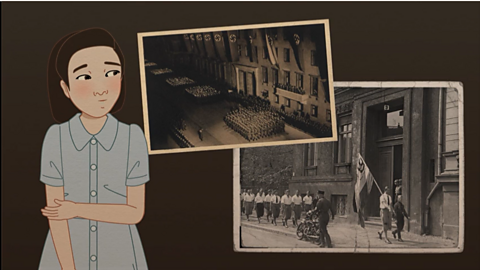
- count1 of 10

- count2 of 10
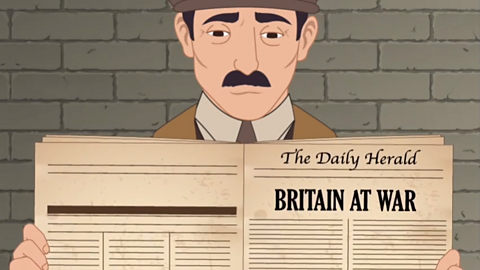
- count3 of 10
